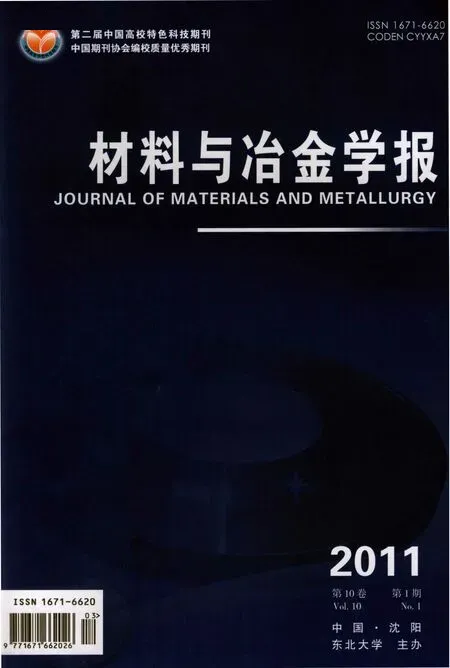A study on mechanical properties of iron matrix composite reinforced by different types of ceramic particles
2011-12-28LIJieZONGYapingZHUANGWeibinZHANGYuebo
LI Jie,ZONG Ya-ping,ZHUANG Wei-bin,ZHANG Yue-bo
(Key Laboratory for Anisotropy&Texture of Materials(Ministry of Education),Northeastern University,Shenyang 110004,China)
A study on mechanical properties of iron matrix composite reinforced by different types of ceramic particles
LI Jie,ZONG Ya-ping,ZHUANG Wei-bin,ZHANG Yue-bo
(Key Laboratory for Anisotropy&Texture of Materials(Ministry of Education),Northeastern University,Shenyang 110004,China)
Mechanical properties of iron matrix composites reinforced by different types of ceramic particles(SiC,Cr3C2,TiC and Ti(C,N))prepared by the two-stage resistance sintering were studied experimentally.It was found that tensile strength of SiC/Fe composite shows the highest among the four types of composites.The elongation of all the composites decreases as increasing of reinforcement volume fraction.The stress-strain curves of the composites were simulated by Eshelby approach modeling to reveal the strengthening mechanisms.The modeling and microstructure observations suggest that the strengthening mechanism of the iron matrix composites relies not only on load sharing of the reinforcements but also on reinforcement increasing matrix strength.
iron matrix composite;mechanical properties;strength;Eshelby approach
Particle-reinforced metal matrix composites exhibit high strength,high stiffness and high wearresistance properties by incorporating stiff ceramic reinforcements into the metal matrix[1,2].Their superior properties make these materials attractive for critical applications in engineering.The mechanical properties of iron matrix composites,which were manufactured by liquid-phase sintering,powder metallurgy and hot isotropic press sintering,are not high enough because of the severe decomposition of reinforcing particles[3,4].A two-stage resistance sintering with novel dynamic temperature control technique based on our previous work has been developed,which makes the manufacture feasible and low cost with excellent properties[5~7].However,investigations in the literature have been focused on individual sole type of particle reinforced iron matrix composites respectively and the results have no comparability each other to evaluate different reinforcements due to the enormous difference on preparation technology and on materials microstructure[8~10].It is significant to conduct systematically an investigation with respect to preparation,properties and modeling of iron matrix composites reinforced by different types of ceramic particles.
The aim of the present work is to investigate the mechanical properties of iron matrix composites reinforced by different types of ceramic particles and to reveal the strengthening mechanisms of the composites prepared by dynamic resistance sintering technique.The SiC,TiC,Cr3C2and Ti(C,N)were chosen to study effect of reinforcing particles on properties of the composite.Modeling based on ours previous work[11~13]and microstructure observations are carried out to interpret the experimental results.
1 Materials and methods
The four types of SiC,Cr3C2,TiC and Ti(C,N)particles are all commercial powder products.The average particle size of the ceramic particles and iron powders are 3 μm and 50.6 μm respectively in commercial nominal standard.1 wt.%zinc stearate was added as caking agent and lubricant.All the composites were prepared by two-stage resistancesintering with novel dynamic temperature control technique.
Each powder mixture was blended for 16 h and then was compressed into a block of 60 mm×30 mm ×10 mm under 240 MPa pressure.All the green compact blocks were sintered by a dynamic resistant hot press sintering technology,which has been developed in our laboratory with new equipment adapted from a traditional hot pressing furnace[7].The pressure during the sintering in this study was limited to 40 MPa according to the performance of the ceramic die and the sinter volts were 5 V.The sintering includes two-stages i.e.heating stage and holding stage.The heating up time of the first stage is 100 s and the holding time of the second stage is 200 s.The current was turned on for 1 s and switched off for 1s alternately during the holding stage.
Tensile tests were performed at room temperature with a velocity of 0.3 mm/min.The strength and final elongation by tensile test were measured from the load-displacement curves.The tensile test was carried out on CCS electronical stretcher and in order to obtain whole stress–strain curves both the extensometer and the strain gauge were used.The microstructure of the composites was observed by means of SEM.
2 Models
Following Eshelby’s idea,based on the concept of mismatch strain between the reinforcing particles and the matrix during composite straining,the compliance tensor of the composite with two random types of reinforcements,Cc-1,can be derived[11]:

whereQI=((CI-Cm)SI+Cm)-1(Cm-CI),SIis the Eshelby tensor of particle type 1;Q2=((C2-Cm)S2+Cm)-1(Cm-C2),S2is the Eshelby tensor of particle type 2;L=(I+fI(S1-I)QI+f2(S2-I)Q2)-1(-f1(S1-I)Q1-f2(S2-I)Q2);Iis the unit matrix;f1andf2are the volume fractions of two types of particles respectively;C1,C2andCmare the stiffness tensors of particle type 1,type 2 and the matrix respectively.The composites studied here have only one type of reinforcing particles,sof2=0 andC2=0 in this paper.
Young’s modulus and Poisson ratio of both the reinforcing particles and the matrix are constant within elastic stage of the composite during tension so composite modulus can be calculated by Eq.1.However,when the plastic deformation takes place in composite,that is the matrix begins to yield,the stress and strain of the matrix is no longer linear relationship but may follow the constitutive relation of measured matrix alloy stress-strain curve,and the Young’s modulus and Poisson ratio of the matrix should be substituted by secant ones.The secant modulusEsand the secant Poisson ratio νsof a material are defined as[12]:

The numerical secant modulus of matrix from experimental tensile test curve of the matrix has been used to calculate the secant modulus of the composite at different strains by Eq.1.To begin with a small strain of the matrix,we set a strain increment of 0.001 and repeat the process so that one more point on the curve of the composite can be simulated.After a number of repetitions,the stress–strain curve of the composite will be finally simulated.
3 Results and discussions
Comparison of the tensile strength and hardness for the composites reinforced by different types of ceramic particles is shown in Fig.1.It is shown that the tensile strength of SiC/Fe composites presents the highest value among the four types of the composites,and then the tensile strength falls a series of Cr3C2/Fe,TiC/Fe and Ti(C,N)/Fe composites from high to low.SiC reinforcing particles have higher fracture toughness than the other three types of reinforcing particles,as well as higher hardness[14].These two factors probably make SiC the best reinforcement type in the iron matrix.
The Vickers hardness values of the composites reinforced by different types of particles are given in Fig.1(b).Cr3C2reinforcing particles demonstrate the strongest effect on improving the hardness of the composites.The hardness of the composites shows general the same phenomena as the tensile strength i.e.high tensile strength is generally consistent with high hardness.
Fig.2 illustrates the elongation of the compos-ites reinforced by different types of particles.It shows that elongation of all the composites decreases as the increase of reinforcement volume fraction.The phenomenon can be interpreted by the fact that the addition of brittle ceramic particles raises the brittleness of the composites.As the Fig.2 demonstrates,Ti(C,N)/Fe composite shows the best plasticity rather than SiC/Fe among the four different composites especially when the volume fraction is low.
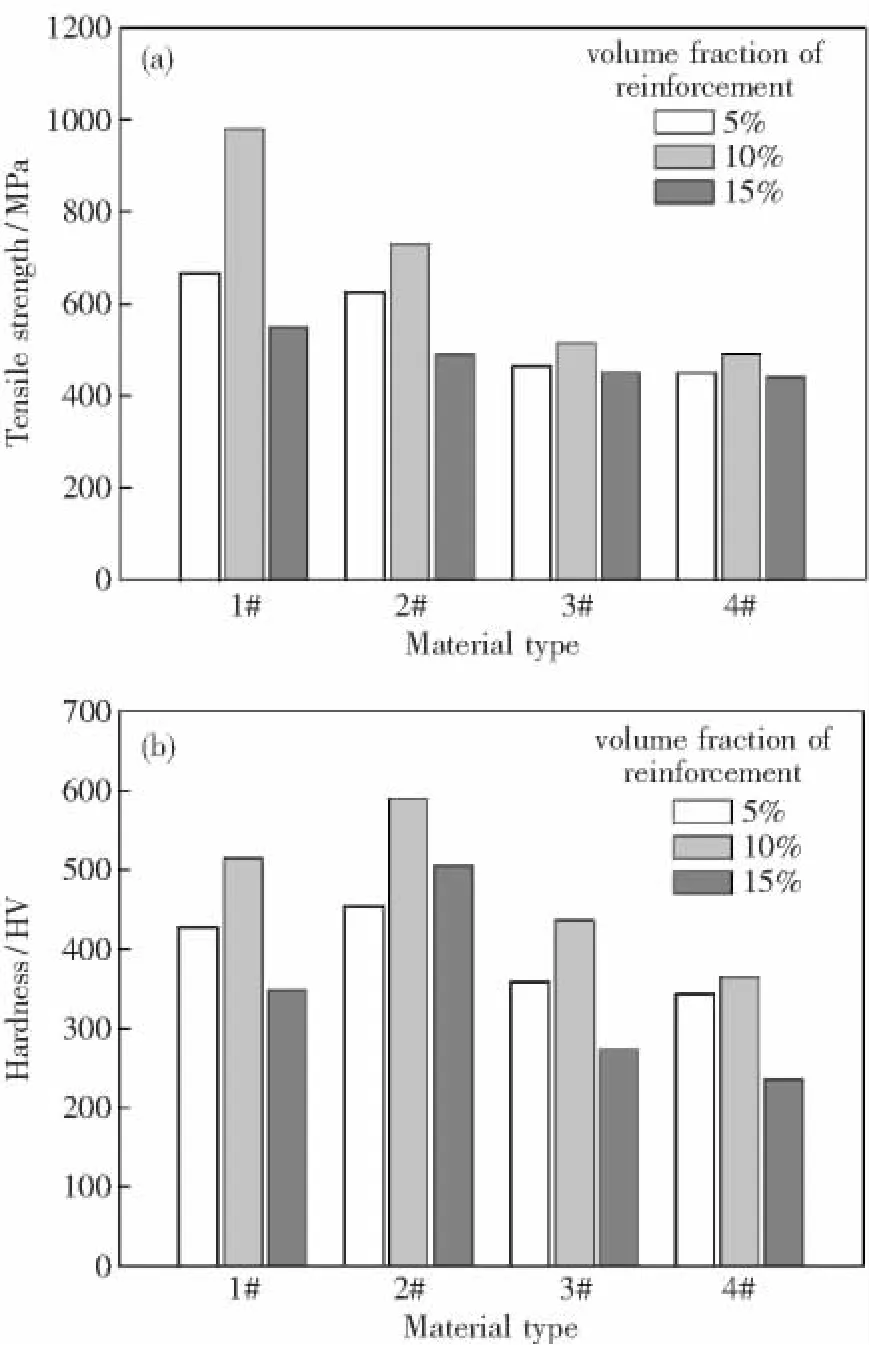
Fig.1 Comparison of the tensile strength and hardness for the composites reinforced by different types of ceramic particles(Material type:1#=SiC/Fe;2#=Cr3C2/Fe; 3#=TiC/Fe;4#=Ti(C,N)/Fe)
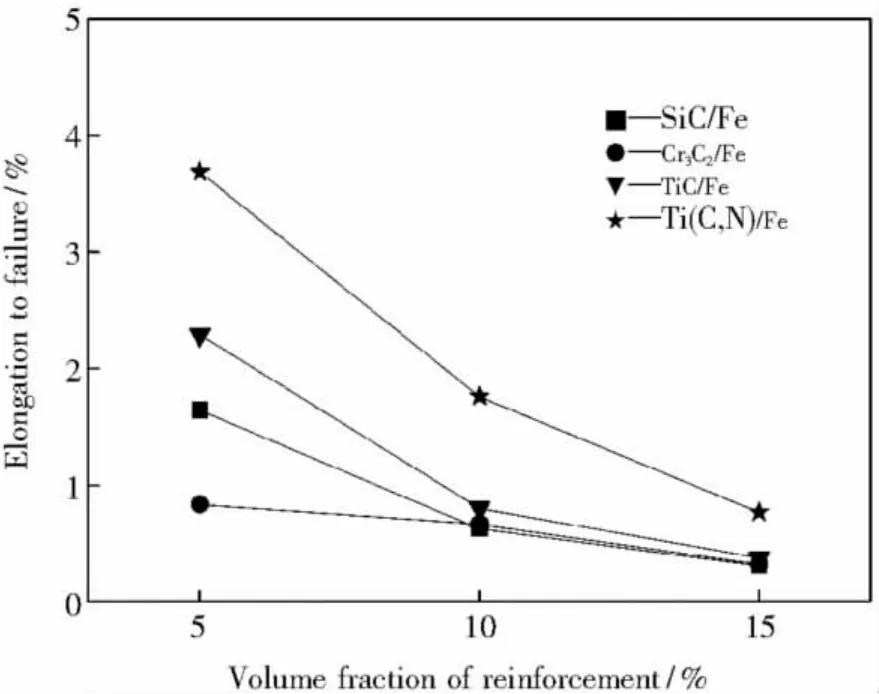
ig.2 The elongation of the composites reinforced by different types of particles
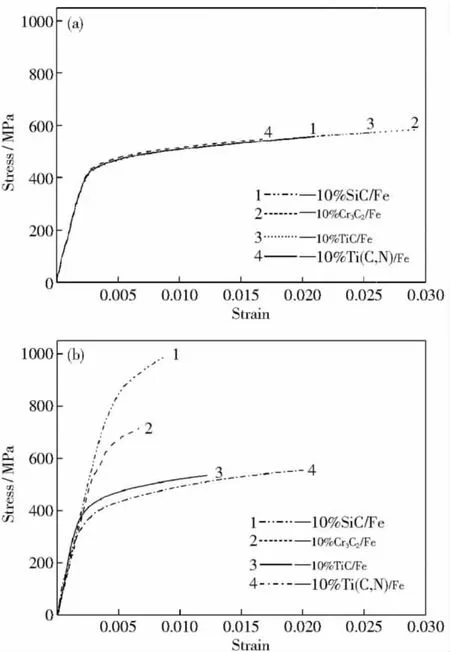
Fig.3 Comparison of the stress–strain curves for the composites between experiments and modeling
The Eshelby approach modeling is applied to simulate the stress-strain curve of iron matrix composites reinforced by different types of ceramic particles and will be compared with the experiment to reveal the strengthening mechanisms.Comparison of the stress-strain curves between modeling and experiments for the composites reinforced by different types of ceramic particles is shown in Fig.3.
It is shown that the curves of TiC/Fe and Ti (C,N)/Fe composite predicted by the modeling agree well with the corresponding experimental curves shown in Fig.3.The agreement between the modeling and the experiment tells us that load sharing of the reinforcements is the chief strengthening mechanism of those composites.However,the experimental stress-train curves of the composites reinforced by SiC and Cr3C2particles are both much higher than the curves predicted by modeling.This suggests that better strengthening effect of the SiC and Cr3C2ceramic particles may come from their good mechan-ical properties and better chemical properties to the iron matrix.
Fig.4 demonstrates the microstructure of the iron matrix composites reinforced by different particles.It can be seen that the SiC and the Cr3C2particles take a slight reaction with iron to form some Pearlite in the matrix shown in the Fig.4(a)and 4 (b).Whereas,the TiC and the Ti(C,N)particles have no reaction with the iron matrix to leave a pure Ferrite microstructure shown in the Fig.4(c)and 4 (d).The Pearlite+Ferrite matrix has much higher strength than the pure ferrite matrix so that the SiC/ Fe and Cr3C2/Fe composites should have much higher strength than the TiC/Fe and Ti(C,N)/Fe composites.This fact can explain why the stressstrain curves by the modeling agree well with those of the experimental TiC/Fe and Ti(C,N)/Fe composites but not with the SiC/Fe and Cr3C2/Fe composites.This suggests that the strengthening mechanism of the composites reinforced by SiC and Cr3C2relies not only on load sharing of the reinforcement but also on increasing matrix strength,while the strengthening mechanism of other two composites only relies on load sharing of the reinforcement.
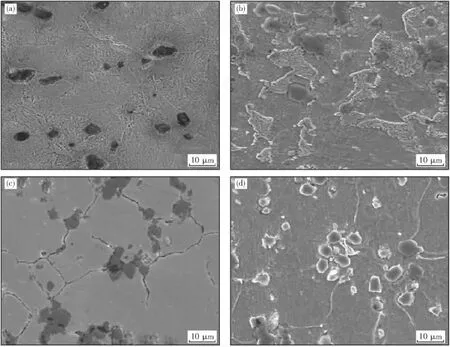
Fig.4 Microstructure of the iron matrix composites reinforced by different particles
4 Conclusions
(1)The tensile strength of SiC/Fe composite shows the highest value among the four types of the composites.The reason may rely on that SiC has higher fracture toughness as well as hardness than the other three types of reinforcements.
(2)The elongation of all the composites decreases as increasing reinforcement volume fraction.However,Ti(C,N)/Fe composite shows the best plasticity rather than SiC/Fe among the four different composites especially when volume fraction is low.
(3)The modeling and microstructure observations suggest that the strengthening mechanism of the iron matrix composites relies not only on load sharing of the reinforcement but also on increasing matrix strength.
[1]Ibrahim I A,Mohamed F A,Lavernia E J.Particulate reinforced metal matrix composites-a review[J].J Mater Sci A,1991,26:1137-1156.
[2]Rabiei A,Vendra L,Kishi T.Fracture behavior of particle reinforced metal matrix composites[J].Compos Part A,2008,39:294-300.
[3]Pelleg J.Reactions in matrix and interface of the Fe-SiC metal matrix composite system[J].Mater Sci Eng A,1999,269: 225-241.
[4]Rosso M.Ceramic and metal matrix composites:Routes and properties[J].J Mater Process Tech,2006,175(1-3): 364-375.
[5]Yang Y F,Zong Y P,Wang G,et al.Manufacture of SiC particulate reinforced iron matrix composites by specimen current heating hot press sintering(in Chinese)[J].Chin J Mater Res,2007,21(1):67-71.
[6]Wang G,Yang Y F,Zong Y P.A study on manufacture of SiCp/Fe composites by specimen current heating hot press sintering[J].Mater Sci Forum,2007,561–565:705-708.
[7]Wang Y M,Zong Y P,Yang Y F,et al.SiC particulate reinforced iron matrix composites processed by current heating hot press sintering[C]//TMS.138th TMS Annual Meeting and Exhibition.San Francisco:Minerals,Metallurgy and Materials Society,2008:395-401.
[8]Bandyopadhyay T K,Das K.Synthesis and characterization of TiC-reinforced iron-based composites Part II on mechanical characterization[J].J Mater Sci,2004,39:6503-6508.
[9]Wang Y S,Ding Y V,Wang J,et al.In situ production of vanadium carbide particulates reinforced iron matrix surface composite by cast-sintering[J].Mater Design,2007,28:2202-2206.
[10]Anal A,Bandyopadhyay T K,Das K J.Synthesis and characterization of TiB2-reinforced iron-based composites[J].Mater Process Tech,2006,172:70-76.
[11]Tan M Z,Zong Y P,Xin Q B,et al.Influence of SiC and Al2O3particulate reinforcements and heat treatments on mechanical properties and damage evolution of Al-2618 metal matrix composites[J].J Mater Sci,2001,36:2045-2053.
[12]Xu N,Zong Y P.Stress in particulate reinforcements and overall stress response on aluminum alloy matrix composites during straining by analytical and numerical modeling[J].Comput Mater Sci,2008,43:1094-1100.
[13]Zong Y P,Wang Y M,Li J,et al.Modeling of mechanical behavior and design of microstructure on particulate reinforced materials[J].Int J Mod Phys B,2009,23:1627-1633.
[14]Kaye G W C,Laby T H.Tables of physical and chemical constants and some mathematical[M].London:Longman Group Ltd,1986:31-105.
TB 333
A
1671-6620(2011)01-0065-05
2010-05-20.
李杰 (1982—),男,浙江宁波人,东北大学博士研究生,E-mail:lijie821016@163.com;宗亚平 (1956—),陕西榆林人,东北大学教授,博士生导师.
